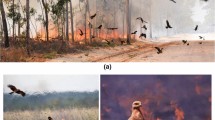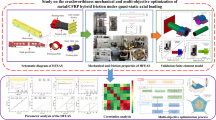Abstract
In this paper, a non-pneumatic tire (NPT) based on the bionic petal structure has been proposed to have high load carrying capacity in low stress level. Firstly, according to GB/T 2977-2008 truck tire specifications, the numerical models of bionic petal NPTs (BP-NPTs) for five different spokes are developed. A set of third-order Bezier curves is introduced to control the geometric configuration. Then, the static and dynamic characteristics of BP-NPTs are investigated numerically, and compared with typical NPTs like Tweel and Hexagonal Honeycomb non-pneumatic wheel (NPW). The results indicate that BP-NPTs have better performance by taking all of these factors into consideration. Also, the influence law of key parameters including the curvature and thickness distribution on the load carrying capacity, the maximum local stresses of spokes and tread under static or dynamic load are obtained. Finally, a multi-objective optimization design method by involving the Hammersley test design, moving least-square agent model and particle swarm optimization is proposed to optimize BP-NPTs. The results demonstrate that the performance of optimized structure is significantly improved. The mass of tire and the maximum stress of spokes under dynamic loads are reduced by 9.3% and 12.3%, respectively, and the load carrying capacity is improved by 10.1%. It is indicated that the BP-NPTs have a bright future in the automobile application.
























Similar content being viewed by others
Data availability
The raw/processed test data required to reproduce these findings cannot be shared at this time due to both legal reasons and time limitations.
References
Andrea G, Dario G, Aleksandr S, Francesco T, Flavio F (2021) Static and dynamic analysis of non-pneumatic tires based on experimental and numerical methods. Appl Sci 11(23):11232–11232
Balchandani D, Nawariya S, Shahid F, Madan AK (2023) Design optimisation and static analysis of non-pneumatic tyres. Int Res J Eng Technol 10(05):723–737
Ganniari-Papageorgiou E, Chatzistergos P, Wang X (2020) The influence of the honeycomb design parameters on the mechanical behavior of non-pneumatic Tires. Int J Appl Mech 12(03):2050024
Hu L, Eeteng Z, Guangjian W, Ng BF (2022) In-plane crushing behavior and energy absoprtion of a novel graded honeycomb from hierarchical architecture. Int J Mech Sci 1(221):107202
Ingrole A, Hao A, Liang R (2017) Design and modeling of auxetic and hybrid honeycomb structures for in-plane property enhancement. Mater Des 117:72–83
Jackowski J, Zmuda M, Wieczorek M, Zuska A (2021) Quasi-static research of ATV/UTV non-pneumatic tires. Energies 14(20):6557–6557
Jin X, Hou C, Fan X, Sun Y, Lv J, Lu C (2018) Investigation on the static and dynamic behaviors of non-pneumatic tires with honeycomb spokes. Compos Struct 187:27–35
Leng Y (2016) Optimization method of support domain radius of moving least squares agent model. Comput Sci 43(S1):95–98
Liang C, Liu H, Mousavi H, Chen K, Asafo DB, Wang G (2022a) Static analysis model of a non-pneumatic tire with elastic spokes contacting with rigid ground. Pro Inst Mech Eng D 236(9):2173–2184
Liang H, Wang Q, Pu Y, Zhao Y, Ma F (2022b) In-plane compressive behavior of a novel self-similar hierarchical honeycomb with design-oriented crashworthiness. Int J Mech Sci 1(209):106723
Liu X, Xu T, Zhu L, Gao F (2022) Multi-objective optimization of the geometry of a non-pneumatic tire for three-dimensional stiffness adaptation. Machines 10(12):1183–1183
Mohamed E, Alaa T, Aboul EH (2018) Bezier curve based path planning in a dynamic field using modified genetic algorithm. J Comput Sci 25:339–350
Mohammad AF, Alireza D (2022) Investigation on the characteristics of a non-penumatic tire with different spoke shapes. In: The 30th annual international conference of Iranian Society of mechanical engineers-ISME2022At: Shahid Beheshti University, Tehran, Iran
Muhammad A, Muhammad M, Azhar H (2022) Design and structural analysis of non-pneumatic tyres for different structures of polyurethane spokes. J Eng Appl Sci 69:38
Phromjan J, Suvanjumrat C (2020a) The modification of steel belt layer of airless tire for finite element analysis. IOP Conf Ser Mater Sci Eng 773:012047
Phromjan J, Suvanjumrat C (2020b) The contact patch analysis of solid tire on drum testing by finite element method. IOP Conf Ser: Mater Sci Eng 886(1):012049
Rugsaj R, Suvanjumrat C (2019) Proper radial spokes of non-pneumatic tire for vertical load supporting by finite element analysis. Int J Automot Technol 20(4):801–812
Rugsaj R, Suvanjumrat C (2021) Dynamic finite element analysis of rolling non-pneumatic tire. Int J Automot Technol 22(4):1011–1022
Shen Y, Hua J, Fan W, Liu Y, Yang X, Chen L (2023) Optimal design and dynamic performance analysis of a fractional-order electrical network-based vehicle mechatronic ISD suspension. Mech Syst Signal Process 184:109718
Sriwijaya R, Tjandra K, Hamzah R (2021) The effect of bank angle on the pressure distribution and deflection of non-pneumatic tires. IOP Conf Ser: Mater Sci Eng 1194(1):012008
Suvanjumrat C, Rugsaj R, Phromjan J (2021) Comparison of two different surface for rolling airless tire by finite element method. IOP Conf Ser Mater Sci Eng 1137(1):012023
Tan H, He Z, Li E, Cheng A, Chen T, Tan X, Li Q, Xu B (2021) Crashworthiness design and multi-objective optimization of a novel auxetic hierarchical honeycomb crash box. Struct Multidisc Optim 64(4):2009–2024
Vinay TV, Marattukalam KJ, Varghese SZ, Samuel S (2015) Modeling and analysis of non-pneumatic tyres with hexagonal honeycomb spokes. Int J Recent Technol Mech Electr Eng 1(11):19–24
William R, Shashank B, Amarnath P, Lonny T, Jogn CZ, Timothy BR, Steven MC (2010) Use of orthogonal arrays for efficient evaluation of geometric designs for reducing vibration of a non-pneumatic wheel during high speed rolling. Tire Sci Technol 38(4):3631–3646
Wu T, Li M, Zhu X, Lu X (2020) Research on non-pneumatic tire with gradient anti-tetrachiral structures. Mech Adv Mater Struct 28(22):1–9
Zang L, Wang X, Yan P, Zhao Z (2022) Structural design and characteristics of a non-pneumatic tire with honeycomb structure. Mech Adv Mater Struct 29(25):4066–4073
Zang L, Wang X, Chen Y, Li Y, Jin H, Yang G (2022) Investigation on mechanical characteristics of non-pneumatic tire with rhombus structure under complex pavement conditions. Simul Model Pract Theory 116:102494
Zeng H, Wang L, Sun H, Wu T, Gao Q (2022) Optimized design of straight bevel gear tooth root transition surface. Struct Multidisc Optim 65(1):36
Zhang T, Yang C, Chen H, Sun L, Deng K (2020) Multi-objective optimization operation of the green energy island based on Hammersley sequence sampling. Energy Convers Manage 204(C):112316
Zhang Z, Fu H, Zhao Q, Tan D, Yang K (2021) Pattern design and performance analysis of a flexible spoke bionic non-pneumatic tire. J Braz Soc Mech Sci Eng 43:41
Zhao Y, Du X, Lin F, Wang Q, Fu H (2018) Static stiffness characteristics of a new non-pneumatic tire with different hinge structure and distribution. J Mech Sci Technol 32(7):3057–3064
Zheng S, Zhang H (2017) Analysis of design scheme of petal-shaped latticed shell structure. Steel Constr 32(04):60–63
Zhou Z, Subhnash R, Ramin S (2022) Multi-axis stiffness and road contact characteristics of honeycomb wheels: a parametric analysis using Taguchi method. Compos Struct 279(1):114735
Zhu L, Xu T, Liu X, Wu M, Zhou X, Gao F (2023) Test and simulation study on the static load and pure longitudinal slip characteristics of non-pneumatic tire. Machines 11(1):1–17
Acknowledgements
This work was supported by National Science Foundation for Young Scientist of China (52102421), the State Key Laboratory of Automotive Safety and Energy under Project No. KFZ2202, Nanjing Overseas Students Science and Technology Innovation Project (1102002309), Key Laboratory of Ministry of Education for Coastal Disaster and Protection, Hohai University (Z202203), Science and Technology Innovation Project for Overseas Students in Nanjing (1102002309), the Research Grants Council of the Hong Kong Special Administrative Region, China (Project No. CUHK14202219), The Chinese University of Hong Kong (Project ID: 3133325), and Fundamental Research Funds for the Central Universities (3202002201C3).
Author information
Authors and Affiliations
Corresponding author
Ethics declarations
Conflict of interest
We declare that we have no financial and personal relationships with other people or organizations that can inappropriately influence our work, there is no professional or other personal interest of any nature or kind in any product, service and/or company that could be constructed as influencing the position presented in, or the review of, the manuscript entitled, “Performance analysis and multi-objective optimization of a Non-Pneumatic Tire with Bionic Petal Spokes”.
Replication of results
The results presented in this paper can be replicated using software Abaqus, Matlab and Python. The data and codes will be available once requested.
Additional information
Responsible Editor: Hongyi Xu
Publisher's Note
Springer Nature remains neutral with regard to jurisdictional claims in published maps and institutional affiliations.
Rights and permissions
Springer Nature or its licensor (e.g. a society or other partner) holds exclusive rights to this article under a publishing agreement with the author(s) or other rightsholder(s); author self-archiving of the accepted manuscript version of this article is solely governed by the terms of such publishing agreement and applicable law.
About this article
Cite this article
Wang, J., Zeng, H., Gao, Q. et al. Performance analysis and multi-objective optimization of a non-pneumatic tire with bionic petal spokes. Struct Multidisc Optim 66, 194 (2023). https://doi.org/10.1007/s00158-023-03636-3
Received:
Revised:
Accepted:
Published:
DOI: https://doi.org/10.1007/s00158-023-03636-3




